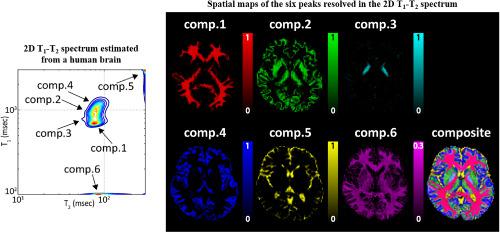当前位置:
X-MOL 学术
›
NMR Biomed.
›
论文详情
Our official English website, www.x-mol.net, welcomes your
feedback! (Note: you will need to create a separate account there.)
Multidimensional correlation spectroscopic imaging of exponential decays: From theoretical principles to in vivo human applications.
NMR in Biomedicine ( IF 2.7 ) Pub Date : 2020-01-07 , DOI: 10.1002/nbm.4244 Daeun Kim 1, 2 , Jessica L Wisnowski 3, 4 , Christopher T Nguyen 5, 6, 7 , Justin P Haldar 1, 2
NMR in Biomedicine ( IF 2.7 ) Pub Date : 2020-01-07 , DOI: 10.1002/nbm.4244 Daeun Kim 1, 2 , Jessica L Wisnowski 3, 4 , Christopher T Nguyen 5, 6, 7 , Justin P Haldar 1, 2
Affiliation

|
Multiexponential modeling of relaxation or diffusion MR signal decays is a popular approach for estimating and spatially mapping different microstructural tissue compartments. While this approach can be quite powerful, it is also limited by the fact that one‐dimensional multiexponential modeling is an ill‐posed inverse problem with substantial ambiguities. In this article, we present an overview of a recent multidimensional correlation spectroscopic imaging approach to this problem. This approach helps to alleviate ill‐posedness by making advantageous use of multidimensional contrast encoding (e.g., 2D diffusion–relaxation encoding or 2D relaxation–relaxation encoding) combined with a regularized spatial–spectral estimation procedure. Theoretical calculations, simulations, and experimental results are used to illustrate the benefits of this approach relative to classical methods. In addition, we demonstrate an initial proof‐of‐principle application of this kind of approach to in vivo human MRI experiments.
中文翻译:

指数衰减的多维相关光谱成像:从理论原理到体内人体应用。
弛豫或扩散 MR 信号衰减的多指数建模是一种流行的方法,用于估计和空间映射不同的微观结构组织隔室。虽然这种方法可能非常强大,但它也受到这样一个事实的限制,即一维多指数建模是一个具有大量歧义的不适定逆问题。在本文中,我们概述了最近针对该问题的多维相关光谱成像方法。这种方法通过有利地使用多维对比度编码(例如,2D 扩散-松弛编码或 2D 松弛-松弛编码)与正则化的空间-光谱估计程序相结合,有助于减轻不适定性。理论计算、模拟、实验结果用于说明这种方法相对于经典方法的好处。此外,我们展示了这种方法在体内人体 MRI 实验中的初步原理验证应用。
更新日期:2020-01-07
中文翻译:

指数衰减的多维相关光谱成像:从理论原理到体内人体应用。
弛豫或扩散 MR 信号衰减的多指数建模是一种流行的方法,用于估计和空间映射不同的微观结构组织隔室。虽然这种方法可能非常强大,但它也受到这样一个事实的限制,即一维多指数建模是一个具有大量歧义的不适定逆问题。在本文中,我们概述了最近针对该问题的多维相关光谱成像方法。这种方法通过有利地使用多维对比度编码(例如,2D 扩散-松弛编码或 2D 松弛-松弛编码)与正则化的空间-光谱估计程序相结合,有助于减轻不适定性。理论计算、模拟、实验结果用于说明这种方法相对于经典方法的好处。此外,我们展示了这种方法在体内人体 MRI 实验中的初步原理验证应用。











































 京公网安备 11010802027423号
京公网安备 11010802027423号